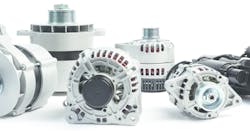The starter, alternator and battery all work together to supply electrical power to a vehicle. The battery stores energy and supplies it to the starter. The alternator then supplies power to all of the electrical accessories, as well as back to the battery to keep it charged. Yes, it's pretty straightforward. But there's a lot going on within that chain of events. Thus, there's a lot that can go wrong.
As a comparison, it's quite similar to how the human body functions. The heart (battery) pumps blood (electrical energy) throughout the body (vehicle). Without properly functioning arteries and veins, things can start to malfunction. That's why Rob Steele, application engineering manager for starters and alternators at BorgWarner, says fleets cannot overlook the cables, which could be considered the main arteries and veins of an electrical system.
"Heavy cables and the associated connections interlock the battery, starter and alternator to one another and to the rest of the vehicle electrical system," Steele says. "It is the electrical highway in which energy is delivered. If you have restrictions or slowdowns in the form of voltage drops due to frayed wires, loose connections or corrosion, the system becomes less efficient."
BorgWarner is a leader in technology solutions for combustion, hybrid and electric vehicles. Its brand includes Delco Remy Genuine Products - Starters & Alternators.
All four electrical system components (battery, starter, alternator and cables) have one thing in common: Operating environment can impact reliability. High temperatures, vibration and corrosive contaminants attack electrical system components. Preventive maintenance is the key to system performance and longevity.
Troubleshooting and preventive maintenance
Whenever there is an electrical issue, the first thing a fleet should verify is the battery state of charge to ensure that it is capable of providing the necessary power to the starter.
"Next, check all the cables and connections for tightness and voltage drop," says Bob Hopko, business development manager for rotating electric at Mahle Aftermarket. "You'd be surprised how many people think it's a warranty claim on a starter or alternator when it's really just an issue with a cable."
Mahle is a leading manufacturer of automotive components, tools and equipment.
"The alternator interfaces with the vehicle's computer system because of load management," Hopko continues. "By monitoring the duty cycle of the alternator, the computer is able to determine if the load on the vehicle is exceeding the alternator's capacity. Through thermal expansion, connections can become loose. Loose connections can add to voltage drop. Voltage is how the computer determines battery condition and state of charge."
It is recommended to conduct a voltage drop test of the cables per TMC RP-129, the Technology & Maintenance Council's recommended practice for heavy duty starting and charging systems. TMC RP-129 stipulates no more than a 0.5V drop for medium and heavy duty trucks.
"Checking the cables and connections and testing for voltage drop is something every fleet manager should do, but it's not something they always do," BorgWarner’s Steele says. "When there's an alternator problem, the instinct is to jump right into the alternator. They end up replacing it, but continue to have the same problem."
Steele says he understands the pressures fleets are under to solve problems quickly. However, taking the time to inspect the cables and connections can save a lot of time and money long-term. It doesn't have to be daunting either.
"Let's say you have an alternator that comes out of the factory with a 0.35V cable drop," Steele says. "It doesn't take a whole lot of time to clean up the fasteners and joints and torque the fasteners back to where they were when the part left the factory. The connections will naturally relax over time, but you'll have a much more efficient system if you keep it all clean and tight. You should include battery and cable voltage drop testing as part of your regular PM schedule so that it is done at least once a year, or as recommended by your vehicle manufacturer."
It's also a good idea to regularly check for debris and corrosion. Hopko says fleets should inspect starters and alternators on a weekly basis or every 1,000 to 1,500 miles, cleaning and tightening as needed. On the alternator, pay close attention to the cooling ports.
"You can typically just brush those areas clean of dirt and debris," Hopko says. "Also, be sure to regularly check alternator belt tension and condition."
If corrosion is present, a more thorough cleaning will be needed. That's why it's important to regularly inspect the connections before anything gets out of hand.
On that note, Steele says an occasional steam cleaning is something fleets can benefit from.
"We see many bus transit customers doing this monthly,” Steele says. “A lot of sand, salt, oil and other road grime gets up under the hood. If you have loose joints or connections, this can become an even bigger problem. You don't need a pressure washer or any special solvents to help keep it clean. A nice, hot bucket of water will often do."
Regular inspection, cleaning and maintenance is important for not only electrical system longevity, but also vehicle efficiency. Energy is taken out of the engine to create electricity. Voltage drop wastes that energy. Thus, reduced voltage drop increases energy efficiency. And, increased energy efficiency increases fuel economy.
"It's probably not enough to notice every time you fill up," Steele says. "But if you put on 100,000 miles in a year, that's going to add up."
Choosing the right replacement
At some point fleets will likely need to replace a starter and/or alternator—or perhaps just want to upgrade to a more efficient option.
"Always go with an OEM-quality product," Mahle’s Hopko says. "There are many aftermarket products out there that say 'new,' but are inconsistent when it comes to quality. You'll never go wrong when dealing with top OE manufacturers."
To that end, Hopko says reman is a solid option, so long as the starter or alternator is remanufactured using OEM-quality parts. Whichever route fleets choose to go, Hopko has one other piece of advice: Don't skimp.
"When you have to replace a starter or alternator on a Class 5 to Class 8 truck, it's important to choose one with at least the same amperage and kilowatts," Hopko says. "Some fleet managers want to save a few bucks, but that isn't a good idea. You're always better to have too much than not enough." This means adjusting and increasing the specification output accordingly, also referred to as “oversizing” the starter or alternator.
Starters are fairly straightforward. Gear-reduction starters have become the most common due to their lower power consumption and increased torque. They cost more, but the benefits are generally perceived to outweigh the increased cost.
"Gear-reduction starters put less drain on battery charging systems," Hopko says. "So you really shouldn't skimp here either. Think about this: A refrigerated unit could lose a full load, and that would be far more costly."
Beyond that, a higher-kW starter should be considered if operated with high parasitic loads on the engine or in cold-climate regions.
"When in doubt, go with a higher cranking output," BorgWarner’s Steele says.
Alternators are more dynamic and give fleets more to think about.
"You have a choice between internal and external fans," Hopko says. "Regulators are multi-function and must integrate with the vehicle's computer system. That can be problematic from a compatibility standpoint. It's important to have a good supplier to help match the right alternator to your vehicle and its application."
Application is an important consideration. One thing to be aware of is if conditions have changed since an alternator was last spec'd for a given vehicle.
"If average loads have increased, you'll want to upgrade to a higher-output machine," Steele says. "A good rule of thumb is to size the alternator so that the average alternator demand is less than half of the rated output. When upgrading to a larger-output alternator, cable sizing should also be checked to assure it will meet the voltage drop requirements at the rated output."
So how does a fleet identify a vehicle's average alternator demand?
"As a rule of thumb, long-haul trucks, and even sleepers, generally average 50 to 70 amps over time," Steele says. Thus, fleets would want a 100- to 140-amp alternator at the very least.
Fleets also have to consider usage patterns and the effect they have on battery drain.
"There are always peaks, like when running a microwave or TV," Steele points out. "Sometimes the vehicle won't start the next morning because the battery bank hasn't had time to recharge. An oversized alternator would cut down on the recharge rate."
Additionally, local delivery trucks can benefit from a higher-output alternator. The constant starting/stopping, deep discharges and high-cycle demand can lead to batteries not getting charged fast enough.
This is why Steve Rosenbloom, a compliance engineer at C.E. Niehoff, says fleets should not completely rely upon nameplate output ratings.
"You should compare the alternator capacity at high ambient temperature to the expected speed range of the vehicle engine in your specific application," Rosenbloom says. "Then, compare that capacity to the expected worst-case vehicle load while also allowing for excess alternator capacity. This helps to ensure that the batteries fully recharge during a typical drive cycle."
C.E. Niehoff designs and manufactures heavy duty brushless alternators.
Speed range and temperature are two influential variables.
With respect to speed range, average engine cruising speed, for example, is more important to long-haul trucks. Average engine low idle speed, on the other hand, is more important to in-city delivery vehicles.
Temperature factors in as well. An alternator's nameplate output rating is taken at a shaft speed of 6,000 rpm and with 22 degrees C (about 72 degrees F) ambient cooling air per SAE J56 and ISO 8554. However, the reality is that alternator output at typical ambient engine air temperature is less than at ambient room temperature.
"This effect is referred to as derating and is due primarily to the increase in alternator internal copper resistance with increasing temperature," says Ciaran Patterson, chief engineer at C.E. Niehoff. "So a fleet manager should look at alternator capacity curves over the entire speed range—while also remembering that the published 22-degree C curves will need to be reduced by up to 15 percent to account for this effect. Understanding alternator output curve will help you select an alternator with adequate capacity to support not only vehicle loads, but also provide for complete battery recharging in a time period corresponding to the shortest drive cycle for the vehicle application."
There are other benefits to oversizing an alternator. Potential fuel savings is one.
"Alternators convert mechanical energy into electrical energy," Steele says. "Some alternators are in the high-60s in terms of efficiency. If you go up in size a bit, you might get to 72 percent efficiency. Just those few percentage points on a 500hp engine can really translate into fuel savings. Some fleets have shown a positive ROI in a year or two."
One more potential benefit of an oversized alternator is life expectancy. Because it is oversized, it is generally underutilized. Therefore, it runs cooler and can last longer.
Other features that enhance alternator efficiency
Remote sense is a feature than can benefit local fleets. It's not a new technology, but it has become increasingly common. A small sense wire reads actual voltage at the battery, signaling the regulator to increase voltage output to compensate for any loss in the heavy cables. This allows for a higher battery state of charge, as well as faster battery recharge rates.
"Even a half volt difference can cut recharge time in half," BorgWarner’s Steele says.
Brushless technology is also becoming more popular. The main benefits are fewer parts and longer life. Brushless alternators do cost more. If a fleet plans on keeping the vehicle for more than a couple of years, brushless could be worth the price premium.
"A brushless alternator is a bit more complex," Steele says. "But maintenance is easier because there are no brushes. All you really have to do is keep it clean so it gets good airflow. Then it will run cooler and you'll get more performance and life out of it." Delco Remy Genuine Products offers both brushed and brushless alternators.
C.E. Niehoff offers brushless exclusively. Since bearings represent the only consumable item, bearing life is critical to the overall longevity of the alternator, Rosenbloom says. Thus, it should be an important area of scrutiny when comparing brushless alternators.
"Bearing life is determined by the mechanical forces on the bearings due to belt tension in combination with alternator torque," Rosenbloom says. "Bearing life is also determined by the quality of the bearing grease, its suitability for the application environment and by how well the bearing grease is protected from contamination by sand, dust, water, etc."
At the other end of the spectrum are companies like Mahle that have continued to focus solely on brushed alternators.
"Yes, brushes can get dust hung up on them," Hopko says. "But a good, quality carbon-brushed alternator can still last a long time. We've gone to a smaller slip ring diameter to allow space for longer brushes that wear longer. We've gone to special alloys in the slip ring, and ensure that bearings are rated to 18,000 rpm for more durability.
"As a fleet manager, you have to determine what is best for your particular fleet," Hopko continues. "Maybe you'll have some vehicles with brushed units and some vehicles with brushless. Then see which last longer. Even with brushless, other things can go wrong and the alternator can still fail. So you need to take all things into consideration."




